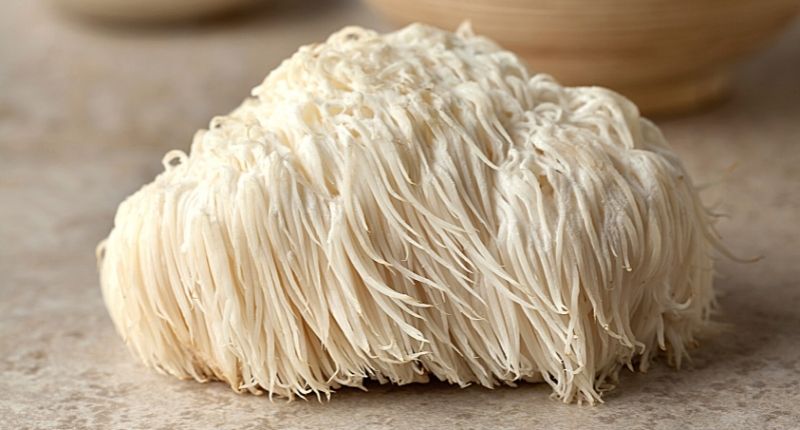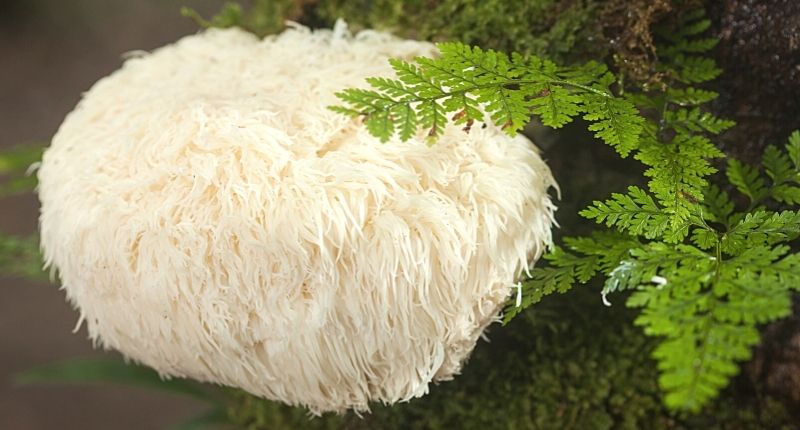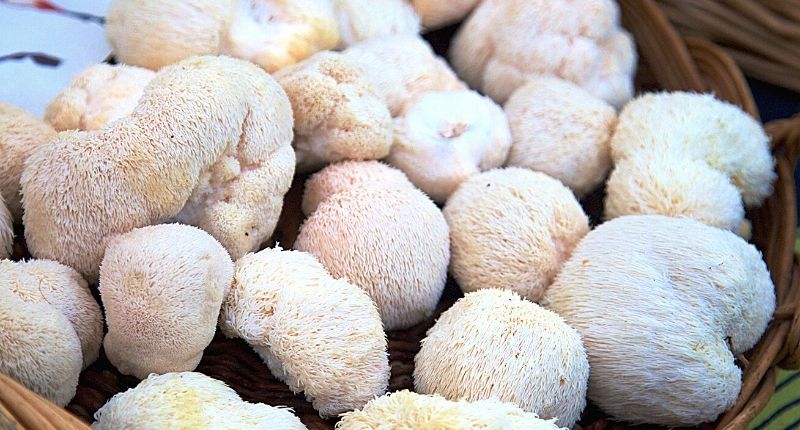Lion’s Mane is a type of edible mushroom with a long history of use in traditional medicine. It goes by many names thanks to its unique, spiny appearance.
You may hear Lion’s Mane referred to as monkey head mushroom, the bearded tooth mushroom, the pom-pom mushroom, Satyr’s beard, or the bearded tooth fungus. Even the Latin genus Hericium pays homage to the mushroom’s spiky structure, roughly translating to “hedgehog.”
What Is Lion’s Mane?
People have been using Lion’s Mane for medicinal purposes for as long as 2,000 years. The fungus was a common ingredient in ancient Chinese and Japanese tonics to support health and longevity. In addition, Buddhist monks historically drank Lion’s Mane tea to improve focus and aid in meditation.
Thanks to their complex yet delicate flavour, fruiting bodies are also a popular ingredient in gourmet cooking. Many chefs compare the taste of Lion’s Mane to that of crab or lobster, making it a popular fixture in seafood dishes.
There are a couple of different Lion’s Mane mushroom varieties, all prized for medicinal and culinary uses. The three most common strains include:
- Hericium Erinaceus: Native to Europe and Asia
- Hericium Americanum: Native to North America
- Hericium Coralloides: Native to Australia and New Zealand
Ecology
You can quickly identify a Lion’s Mane mushroom thanks to its unique appearance. As the name suggests, the fungus has a distinctively hairy appearance. Spines, or gills, grow in large clumps that dangle downwards like icicles, while the body is generally globe-shaped.

Most fruiting bodies are white or ivory, especially when it comes to younger mushroom specimens. As Lion’s Mane ages, it may take on a darker yellow or brown hue. While gills start out around 1 cm in length, they can grow as long as 5 cm under optimal conditions.
In North America, you can find wild Lion’s Mane growing on hardwood trees in the late summer or early fall. Its partial to the American Beech, though you can find it growing on other types of trees. Though the Lion’s Mane mushroom prefers to feed on dead wood, parasitic growths also occur on living trees.
Wild Lion’s Mane can display healthy growth for decades in the right environment. The fungus can be found intermittently on the same tree for as long as 20 years. Evidence also suggests that a healthy Lion’s Mane plant may survive up to 40 years under the right conditions.
Benefits of Lion’s Mane
Lion’s Mane mushrooms offer a whole host of health benefits, whether you enjoy them cooked or in a supplement. The fruiting bodies contain β-glucan polysaccharides, which can help to lower cholesterol, regulate blood sugar, and support the immune system. Lion’s Mane is also anti-inflammatory and antimicrobial.
Neuroprotective Properties
Historically, one of the most common uses of Lion’s Mane was to improve mental clarity and focus. Indeed, studies show the mushroom helps to stimulate the growth of new, healthy brain cells thanks to compounds such as hericenones and erinacines.
The neuroprotective properties of Lion’s Many may work to combat memory loss and even reduce the risk of cognitive decline and dementia.
Anti-inflammatory
Lion’s Mane is also prized for its anti-inflammatory properties, helping to improve digestive function, boost the immune system, and speed up recovery times. In particular, Lion’s Mane can help to stimulate the recovery of nerve cells and even encourage new growth.
The mushroom’s anti-inflammatory effects may also reduce the risk of anxiety and depression in susceptible individuals. It may also improve function in the hippocampus, which regulates emotion.
Blood Sugar Regulation
Some people with diabetes use Lion’s Mane to help control blood sugar and manage their symptoms. The mushroom works to lower blood sugar levels by blocking the breakdown of carbs in the lower intestine. It may also reduce diabetic inflammation and pain in the hands and feet.
Metabolism
Regularly eating Lion’s Mane or taking supplements may help people manage their weight and reduce the risk of heart disease. In addition, studies have shown that the mushroom works to improve metabolic function while lowering unhealthy triglyceride levels.
Other Potential Uses
There is some evidence that Lion’s Mane may work to protect against cancer thanks to antioxidants and other unique natural compounds. Studies have shown that Lion’s Mane can reduce the spread of several types of cancer, including lung, liver, stomach, and colon cancer. However, more evidence is needed to draw definitive conclusions.
Legality in the U.S.
Lion’s Mane mushroom is relatively rare in most parts of the world. In places like the U.K., it’s considered a threatened species and thus earns a high level of legal protection. Harvesting or selling the fungus is illegal.
In the U.S., however, legality varies between states. In most areas, Lion’s Mane mushroom is completely legal to buy and sell. You may even see mushrooms at your local farmer’s market or grocery store.

In states such as California, you need a special license to harvest, sell, or keep medicinal mushrooms such as the Lion’s Mane. Therefore, it’s always important to check local laws before you decide to grow or purchase Lion’s Mane mushrooms.
Where Can I Buy In North America?
It can be a challenge to find specialty mushrooms at your local grocery store. Fortunately, however, the popularity of strains such as Lion’s Mane is driving a rapid increase in production. Between 2010 and 2018, the U.S. increased the production of specialty mushrooms by almost a quarter to keep up with rising demand.
Nowadays, there are a couple of commercially available Lion’s Head strains that you can find from specialty nurseries, breeders, or even online. With a supply of spores, you can start cultivating your very own Lion’s Mane at home.
One of the easiest ways to enjoy the health benefits of Lion’s Mane is by using supplements. They’re much more readily available then spores or fruit while still offering the same support for memory, nerves, digestion, and more. In addition, you can check out your local pharmacy or go online to find healthy, holistic Lion’s Mane supplements.
How to Grow and Cultivate Lion’s Mane
Lion’s Mane is relatively easy to cultivate as long as you have the proper substrate and surrounding environment. The fungus needs a steady supply of carbon and nitrogen to sustain healthy growth and a pH of around 5.0 to 9.0. A slightly acidic pH of 6.0 is ideal.
You can use either a solid or liquid substrate to grow Lion’s Mane. When using a solid substrate, most people choose to use an artificial log made of hardwood sawdust. However, to add extra nutrients, the sawdust often gets mixed with other components such as wheat bran, rice straw, cornmeal, or soybean.
The most common liquid substrate for growing Lion’s Mane is glucose, as it offers an excellent carbon source for growing fungi. Adding soybean, corn, or wheat bran can help to introduce a healthy nitrogen source.
How to Grow
It’s important to sterilise the substrate before inoculation, preferably with heat. Doing this will kill any fungal spores that might compete with your mushroom and any bacteria that may threaten its health.
Once your substrate is ready, you can inoculate it with Lion’s Mane spores before incubating it at around 68°F to 75°F. It generally takes two to three weeks for the fungus to colonise fully. If you don’t want to wait, you can find growing kits that come with a pre-inoculated and pre-incubated substrate.
A colony of Lion’s Mane will fruit when given access to fresh air, shade, and humidity. Once you see fruiting bodies start to form, it should take around two weeks before they’re ready to harvest. Gently cut gills close to the base and store them in the fridge for up to a week.
Lion’s Mane is a fairly hardy mushroom that holds its own against disease and competition alike. However, it is susceptible to infection with the parasite Brennandania lambi. If left unchecked, this mite can breed and infest an entire Lion’s Mane colony, eventually resulting in death.
Once established, it can be difficult to control a colony of B. lambi. Therefore, it’s essential to follow proper pasteurisation processes when setting up your Lion’s Mane colony. In addition, always sterilise your substrate and make sure you wear clean gloves and clothing when handling.
How to Use & Best Practices
When dealing with fresh Lion’s Mane mushrooms, it’s best to opt for young, light-coloured fruits. These often have the sweetest flavour and are tender when cooked. It’s best to store them in the fridge with plenty of ventilation, though they’ll last for a day or two at room temperature.
If you don’t plan on cooking your mushrooms within a week or so, it’s best to dry them out with a food dehydrator to preserve them. You can eat dried mushrooms as-is or reconstitute them later for cooking.
When taking Lion’s Mane as a supplement, it’s a good idea to consult your doctor about scheduling and dosage. How much you take will depend on your age, gender, size, and overall sensitivity to supplements.
